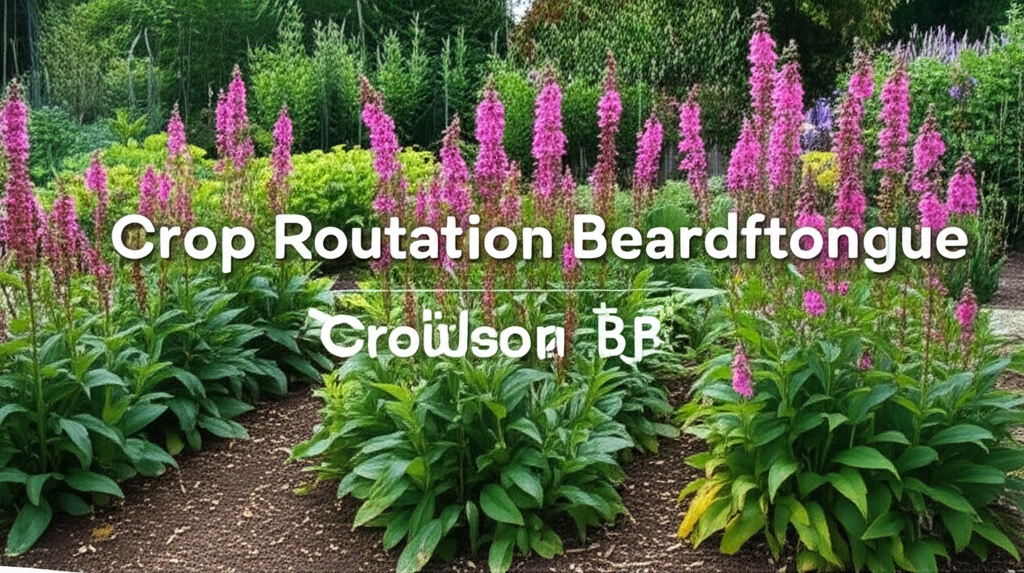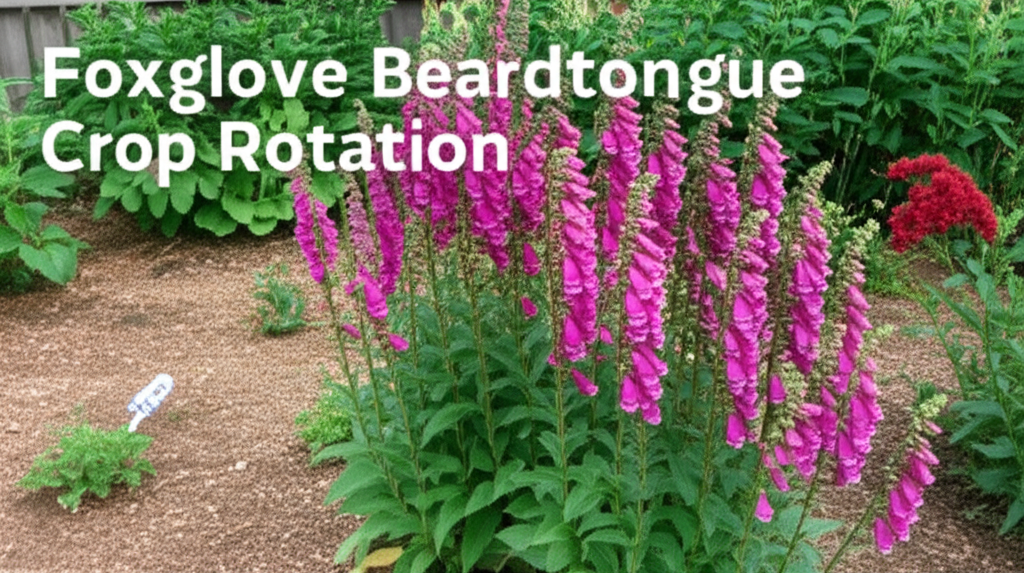Understanding Foxglove Beardtongue and Crop Rotation
Foxglove Beardtongue, scientifically known as Penstemon digitalis, is a striking native perennial that adds significant ornamental value to any garden. Renowned for its tall spires of tubular, white to pale lavender flowers, it attracts a wealth of pollinators, including bees, butterflies, and hummingbirds. Its adaptability to various soil types and its drought tolerance make it a favored choice for many gardeners. However, like all plants, Penstemon digitalis benefits immensely from thoughtful garden planning, particularly when it comes to crop rotation.
Crop rotation is a fundamental horticultural practice that involves systematically changing the crops planted in a specific area of a garden over time. Its primary goals are to improve soil health, manage pests and diseases, and optimize nutrient uptake. By rotating crops, gardeners can break the life cycles of soil-borne pathogens and pests that tend to build up when the same plant family is grown repeatedly in the same spot. It also helps in balancing soil nutrient levels, as different plants have varying demands for specific nutrients.
While often associated with annual vegetable gardens, the principles of crop rotation are equally applicable to perennial beds, including those featuring Foxglove Beardtongue. Understanding how Penstemon digitalis interacts with the soil and what its potential vulnerabilities are is key to implementing an effective rotation strategy.
Why Crop Rotation Matters for Foxglove Beardtongue
Although Penstemon digitalis is a hardy perennial, neglecting crop rotation within its designated garden bed can lead to several issues:
- Disease Buildup: Certain fungal diseases, such as root rot or powdery mildew, can persist in the soil and affect Penstemon digitalis if it’s planted in the same location year after year. While Penstemon digitalis is generally resistant, prolonged monoculture can eventually weaken its defenses.
- Pest Infestations: Specific pests might target Penstemon digitalis. If these pests find a consistent food source in the same spot, their populations can grow unchecked, leading to more significant damage over time.
- Nutrient Depletion: While Penstemon digitalis is not a particularly heavy feeder, continuous growth in the same soil can deplete certain micronutrients that are essential for its optimal health and flowering.
- Soil Structure Degradation: Over time, the root systems of the same plant type can compact the soil in a specific manner, potentially hindering water and air circulation.
By incorporating crop rotation principles, even within a perennial flower bed, gardeners can create a more resilient and vibrant ecosystem for their Foxglove Beardtongue and surrounding plants.
Key Facts About Foxglove Beardtongue

To effectively plan crop rotations, it’s crucial to understand the basic characteristics of Foxglove Beardtongue.
| Characteristic | Description |
|---|---|
| Scientific Name | Penstemon digitalis |
| Plant Type | Perennial |
| Bloom Time | Late spring to early summer |
| Flower Color | White to pale lavender |
| Sun Exposure | Full sun to partial shade |
| Soil Preference | Adaptable to various soil types, prefers well-drained |
| Native Region | Eastern and Central North America |
| Hardiness Zones | 3-8 |
| Pollinator Attraction | High (bees, butterflies, hummingbirds) |
| Potential Pests/Diseases | Slugs, snails, aphids, powdery mildew (less common) |
Implementing Crop Rotation in a Foxglove Beardtongue Garden Bed
When thinking about crop rotation for a perennial bed, the concept is less about replacing the Penstemon digitalis entirely each year and more about strategically introducing other compatible plants or altering the conditions within the bed over a cycle. This can be achieved through several methods.
Rotation Cycles and Plant Families
A typical crop rotation cycle spans three to five years. For perennial beds, this might translate to managing the bed’s composition over several seasons to allow for regeneration and disease prevention. The key is to avoid planting plants from the same botanical family in the same spot consecutively.
Since Foxglove Beardtongue (Penstemon digitalis) belongs to the Plantaginaceae family (formerly Scrophulariaceae), the rotation strategy should focus on introducing plants from entirely different families.
Example Rotation Plan for a Foxglove Beardtongue Bed
Here’s a hypothetical five-year rotation plan for a garden bed where Penstemon digitalis is a primary feature. This plan involves companion planting and periodic rejuvenation.
Year 1: Established Foxglove Beardtongue with Groundcovers
- Primary Crop: Mature Penstemon digitalis.
- Companion/Groundcover: Low-growing, non-competing perennials from different families.
Sedum species (Crassulaceae family) – succulents that help retain moisture and add textural contrast.
Thymus species (Lamiaceae family) – aromatic herbs that tolerate drought and attract pollinators.
- Soil Management: Mulch with compost to retain moisture and suppress weeds.
Year 2: Companion Planting and Soil Enrichment
- Primary Crop: Penstemon digitalis remains.
- Interplanting: Introduce annuals or biennials from different families that can be easily removed.
Calendula officinalis (Asteraceae family) – cheerful orange flowers that attract beneficial insects.
Eschscholzia californica (Papaveraceae family) – California poppy, a drought-tolerant annual that reseeds easily.
- Soil Management: Top-dress with a balanced organic fertilizer or worm castings to replenish nutrients.
Year 3: Shifting Focus – Cover Cropping/Soil Rejuvenation
- Temporary Removal/Resting Phase: This is where a more traditional rotation element comes into play. The Penstemon digitalis might be divided and replanted, or in some cases, temporarily removed to allow for a cover crop.
- Cover Crop: A legume cover crop like Trifolium repens (White Clover – Fabaceae family) can be planted. Legumes fix nitrogen from the atmosphere, enriching the soil. Alternatively, a non-legume cover crop like Phacelia tanacetifolia (Lacy Phacelia – Boraginaceae family) can improve soil structure and attract pollinators.
- Soil Management: After the cover crop has grown for a season, it can be tilled into the soil to add organic matter.
Year 4: Reintroduction and Diversity
- Primary Crop: Replant Penstemon digitalis (either divisions from the original plants or new ones).
- New Companions: Introduce a new set of compatible perennials or shrubs from different families.
Achillea millefolium (Yarrow – Asteraceae family) – drought-tolerant, attracts beneficial insects.
Coreopsis species (Asteraceae family) – cheerful, long-blooming perennials.
- Soil Management: Amend soil with compost before planting.
Year 5: Established Diversity and Maintenance
- Primary Crop: Continue with Penstemon digitalis.
- Ongoing Companions: Maintain the plants introduced in Year 4.
- Soil Management: Continue with mulching and observational weeding. Look for any signs of pests or diseases that might indicate a need for intervention.
Considerations for Perennial Beds
It’s important to adapt these principles to the nature of perennial gardening. Instead of complete removal of the main plant, the rotation might involve:
- Dividing and Replanting: Periodically dividing and replanting Penstemon digitalis can rejuvenate the plants and allow for soil amendment in the areas temporarily vacated.
- Companion Planting: Introducing compatible plants from different families as understory or border plants.
- Temporary Cover Cropping: As outlined in Year 3, allowing a section of the bed to rest under a cover crop can be highly beneficial.
Benefits and Drawbacks of Rotation for Foxglove Beardtongue
Implementing a crop rotation strategy, even for a perennial like Foxglove Beardtongue, comes with its own set of advantages and potential challenges.
| Pros | Cons |
|---|---|
| Improved Soil Health: Prevents depletion of specific nutrients and encourages a more diverse soil microbiome. | Increased Complexity: Requires more planning and potentially more labor compared to monoculture planting. |
| Reduced Pest and Disease Pressure: Breaks the life cycles of soil-borne pathogens and pests that target Penstemon digitalis. | Temporary Aesthetic Changes: If cover crops or temporary annuals are used, the visual appeal of the bed might change during the rotation cycle. |
| Enhanced Plant Vigor: Healthier soil and reduced stress lead to more robust growth and better flowering. | Space Requirements: If a section of the bed needs to be temporarily cleared for cover cropping, it might require finding temporary space for the Penstemon digitalis or managing divisions elsewhere. |
| Increased Biodiversity: Encourages a wider variety of beneficial insects and microorganisms in the garden ecosystem. | Potential for Competing Roots: Careful selection of companion plants is necessary to avoid root competition with Penstemon digitalis. |
| Better Nutrient Management: Using cover crops like legumes can naturally increase soil nitrogen levels. | Learning Curve: Understanding plant families and their needs can take time and research for gardeners new to rotation. |
Companion Plants for Foxglove Beardtongue Rotation
Choosing the right companion plants is crucial for a successful rotation strategy. These plants should ideally have different nutrient needs, pest susceptibilities, and growth habits to complement Penstemon digitalis.
Beneficial Plant Families to Consider
When planning your rotation, consider plants from these families as either temporary additions or long-term companions:
- Asteraceae (Daisy Family): Includes plants like Echinacea (coneflowers), Coreopsis, Heliopsis (false sunflower), and Aster species. Many are drought-tolerant and attract pollinators.
- Fabaceae (Pea/Legume Family): Such as Lupinus (lupines) or groundcovers like Trifolium (clover). Legumes can fix nitrogen, benefiting the soil.
- Lamiaceae (Mint Family): Includes herbs like Monarda (bee balm), Salvia (sage), and Thymus (thyme). These often have aromatic foliage and attract pollinators.
- Poaceae (Grass Family): Ornamental grasses provide structure, texture, and winter interest. Varieties like Schizachyrium scoparium (Little Bluestem) are native and hardy.
- Boraginaceae (Borage Family): Plants like Phacelia or Myosotis (forget-me-nots) can be beneficial.
Plants to Avoid in Close Proximity or Rotation
While not exhaustive, it’s generally advisable to avoid planting members of the same family too close or in immediate rotation. For example, if you were considering other native plants from a region, check their family affiliations. Some plants that might compete for similar resources or attract similar pests should also be used with caution.
Conclusion: A Healthier Garden Through Rotation
Incorporating crop rotation principles into your Foxglove Beardtongue garden bed is a proactive approach to ensuring the long-term health, vitality, and beauty of your plants. By understanding plant families, soil health, and the benefits of diversity, you can create a thriving ecosystem that minimizes pest and disease issues and maximizes the ornamental impact of your Penstemon digitalis. Even simple adaptations, such as interplanting with beneficial annuals or periodic division and soil amendment, can contribute significantly to a more resilient and rewarding garden. Embracing this practice will undoubtedly lead to a more robust and visually stunning garden for years to come.


